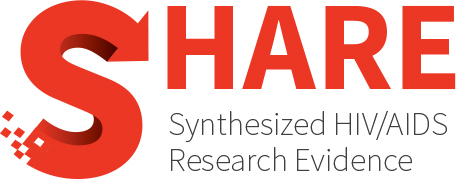Category Archives: Governance arrangements
How decisions about care are made
Implementation strategies to improve HIV care cascade outcomes in low- and middle-income countries: A systematic review from 2014 to 2021
INTRODUCTION: In low- and middle-income countries (LMICs), which are disproportionately affected by the HIV epidemic and manage limited resources, optimized implementation strategies are needed to enhance the efficiency of the...
Discrepancies between self-reported medication in adherence and indirect measurement adherence among patients undergoing antiretroviral therapy: A systematic review
Background Given the critical importance of medication adherence in HIV/AIDS treatment, this study aims to compare medication adherence measured by self-report (SR) and indirect measurement among antiretroviral therapy (ART) patients,...
Missed opportunities for guidance on sexually transmitted infection services: A global review of national HIV PrEP guidance
OBJECTIVES: People who use or would benefit from pre-exposure prophylaxis (PrEP) for HIV infection are disproportionately affected by sexually transmitted infections (STIs). Integrating STI services when offering PrEP fosters synergies...
Magnitude and risk factors of mother-to-child transmission of HIV among HIV-exposed infants after Option B+ implementation in Ethiopia: A systematic review and meta-analysis
Background Mother-to-child transmission (MTCT) of the human immunodeficiency virus (HIV) remains a major public health challenge in Ethiopia. The objective of this review was to assess the pooled magnitude of...
Assessing structural racism and discrimination along the pre-exposure prophylaxis continuum: A systematic review
Structural racism and discrimination (SRD) is deeply embedded across U.S. healthcare institutions, but its impact on health outcomes is challenging to assess. The purpose of this systematic literature review is...
Pre-exposure prophylaxis (PrEP) among people who use drugs: A qualitative scoping review of implementation determinants and change methods
Implementation of pre-exposure prophylaxis (PrEP) to prevent HIV transmission is suboptimal in the United States, particularly among people who use drugs (PWUD). PrEP research among PWUD is scarce, and the...
A systematic review of barriers and facilitators to antenatal screening for HIV, syphilis or hepatitis B in Asia: Perspectives of pregnant women, their relatives and health care providers
BACKGROUND: Despite improvements, the prevalence of HIV, syphilis, and hepatitis B remains high in Asia. These sexually transmitted infections (STIs) can be transmitted from infected mothers to their children. Antenatal...
Restarting pre-exposure prophylaxis (PrEP) for HIV: A systematic review and meta-analysis
Background High coverage of pre-exposure prophylaxis (PrEP) will reduce HIV transmission and help end the HIV/AIDS pandemic. However, PrEP users face challenges, including long-term adherence. The study aimed to document...
A scoping review of the current landscape of pre-exposure prophylaxis and postexposure prophylaxis in India
This scoping review aimed to review and summarize the evidence related to the attitudes toward human immunodeficiency virus (HIV) pre-exposure prophylaxis (PrEP)/postexposure prophylaxis (PEP) among people at risk of HIV,...
Ending HIV transmission in Australia: Expanding PrEP to cisgender women: A scoping review
Pre-exposure prophylaxis (PrEP) availability through the Pharmaceutical Benefits Scheme provides real potential for the elimination of HIV transmission in Australia, as evidenced by a rapid decline in HIV incidence among...
Identifying best practices for increasing HIV pre-exposure prophylaxis (PrEP) use and persistence in the United States: A systematic review
A qualitative systematic review was conducted to evaluate pre-exposure prophylaxis (PrEP) interventions, describe characteristics of best practices for increasing PrEP use and persistence, and explore research gaps based on current...
